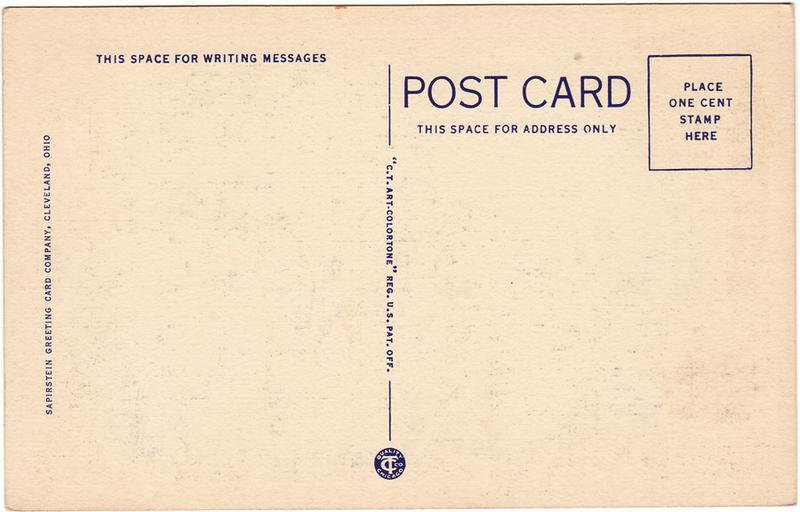MAKE A MEME
View Large Image

| View Original: | Back_of_The_Three_Bridges_and_Ohio_River,_Showing_Children's_Home,_Between_East_Liverpool_and_Steubenville,_Ohio_(Date_Unknown).jpg (900x576) | |||
| Download: | Original | Medium | Small | Thumb |
| Courtesy of: | www.flickr.com | More Like This | ||
| Keywords: postcard postcards unused unknown date unknowndate date unknown dateunknown steubenville steubenville, ohio steubenvilleohio divided back dividedback white border whiteborder white border era whiteborderera c.t. art colortone ctartcolortone curt teich co. curtteichco sapirstein greeting card company sapirsteingreetingcardcompany ohio east liverpool eastliverpool east liverpool, ohio eastliverpoolohio text Description on front of card: The Three Bridges and Ohio River, Showing Children's Home, Between East Liverpool and Steubenville, Ohio No. in Series: 1 Published by: Sapirstein Greeting Card Company, Cleveland, Ohio | C.T. Art-Colortone by Curt Teich Co., Chicago, Illinois Estimated date: Between 1930-1945 Unused. Publisher/Distributor Notes: Polish immigrant Jacob Sapirstein began purchasing cards from German manufacturers and selling them in the Cleveland area shortly after arriving in America in 1905. It became a family operation called the Sapirstein Greeting Card Company. The company started printing its own cards by 1936 and changed its name to American Greetings Publishers during World War II. The company continues to operate today. Source: corporate.americangreetings.com/aboutus/history.html Curt Teich emigrated to Chicago in 1895. He had worked as a lithographer in Lobenstein, Germany. He founded the Curt Teich Company in 1898, concentrating on newspaper and magazine printing. He was an early publisher of postcards, but he didn't begin printing them himself until 1908. According to MetroPostcard.com, "As his competition dwindled, his sales expanded and his American factories would eventually turn out more postcards than any other in the United States. " The company was best known for their wide range of advertising and postcards of North America. By the 1920s, it was producing so many postcards with borders that they became recognized as a type dubbed "White Border Cards," creating an "era." Curt Teich started using offset presses in 1907, but it took a number of years before he had offset presses made to his satisfaction, and many more years for him to perfect the method. His innovations in this printing technique directly led to the production of what we now call "linens" by the early 1930s. The company aided the war effort during the second world war by also printing many military maps. Curt Teich eventually turned management of the company over to his son, but he remained active in company operations throughout its history. Curt Teich died in 1974 and the family business was sold to Regensteiner Publishers who continued to print postcards at the Chicago plant until 1978 when the rights to the company name and processes were sold to the Irish company, John Hinde Ltd. Their California subsidiary now prints postcards under the name John Hinde Curteich, Inc. Source: www.metropostcard.com/publisherst.html Description on front of card: The Three Bridges and Ohio River, Showing Children's Home, Between East Liverpool and Steubenville, Ohio No. in Series: 1 Published by: Sapirstein Greeting Card Company, Cleveland, Ohio | C.T. Art-Colortone by Curt Teich Co., Chicago, Illinois Estimated date: Between 1930-1945 Unused. Publisher/Distributor Notes: Polish immigrant Jacob Sapirstein began purchasing cards from German manufacturers and selling them in the Cleveland area shortly after arriving in America in 1905. It became a family operation called the Sapirstein Greeting Card Company. The company started printing its own cards by 1936 and changed its name to American Greetings Publishers during World War II. The company continues to operate today. Source: corporate.americangreetings.com/aboutus/history.html Curt Teich emigrated to Chicago in 1895. He had worked as a lithographer in Lobenstein, Germany. He founded the Curt Teich Company in 1898, concentrating on newspaper and magazine printing. He was an early publisher of postcards, but he didn't begin printing them himself until 1908. According to MetroPostcard.com, "As his competition dwindled, his sales expanded and his American factories would eventually turn out more postcards than any other in the United States. " The company was best known for their wide range of advertising and postcards of North America. By the 1920s, it was producing so many postcards with borders that they became recognized as a type dubbed "White Border Cards," creating an "era." Curt Teich started using offset presses in 1907, but it took a number of years before he had offset presses made to his satisfaction, and many more years for him to perfect the method. His innovations in this printing technique directly led to the production of what we now call "linens" by the early 1930s. The company aided the war effort during the second world war by also printing many military maps. Curt Teich eventually turned management of the company over to his son, but he remained active in company operations throughout its history. Curt Teich died in 1974 and the family business was sold to Regensteiner Publishers who continued to print postcards at the Chicago plant until 1978 when the rights to the company name and processes were sold to the Irish company, John Hinde Ltd. Their California subsidiary now prints postcards under the name John Hinde Curteich, Inc. Source: www.metropostcard.com/publisherst.html | ||||